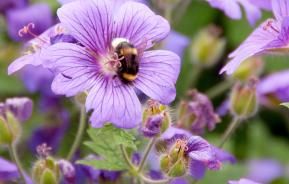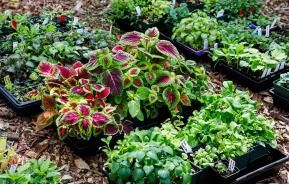Jasmines are very popular deciduous, semi-evergreen or evergreen climbing plants. Most are summer flowering, producing white, cream or pink, scented flowers. Jasminum nudiflorum (winter jasmine) is a wall shrub that, as its name suggests, produces its delightful yellow flowers in winter.
Several summer-flowering species are commonly grown - and some are hardier than others. Jasminum officinale (common summer jasmine), J. beesianum, J. humile and J. x stephanense are generally frost hardy and can be grown outside against a warm, sunny wall. In cold regains, it is better to grow them in a a conservatory or greenhouse.
Jasminum mesnyi and J. polyanthum are not hardy and are best grown as houseplants, preferably in a conservatory or greenhouse.
How to grow jasmine
Cultivation
Indoors, jasmines prefer a brightly lit position, preferably a south-facing or west-facing aspect, but with some protection from strong, burning sunlight in summer. They can be moved outside to a warm, sunny patio in summer - but make sure you bring them back indoors before the weather turns cold and frosty in autumn. They need a minimum temperature of 13-15°C (55-60°F).
Outdoors, summer-flowering jasmines need to be grown in a warm, sunny, sheltered position - preferably a south- or south-west facing aspect. Jasminum nudiflorum tolerates more shade and can also be grown in a a south-east or north-west facing aspect.

Planting jasmine
Indoors
Jasmines are perfect for growing in good-sized pots and other large containers of multi-purpose compost or John Innes compost.
Outside
Dig over the soil thoroughly and add lots of bulky organic matter, such as planting compost, to break up heavy soils and help ensure good drainage.
When growing jasmine in pots, it is ideal to use a good-sized pot and other large containers filled with multi-purpose compost or John Innes compost.
Suggested planting locations and garden types
Flower borders and beds, walls and fences, patios, containers, city and courtyard gardens, houseplant, indoor plant, summer patio plant.
How to care for jasmine
Indoors
Water plants moderately when plants are in growth (April to September), but more sparingly when dormant (autumn and winter).
Feed with a high potash liquid feed (such as a tomato feed) every few weeks during the growing season from late spring to early autumn.
Outside
Water freely during dry weather. Plants growing in containers will need regular watering from spring to the beginning of autumn.
Feed once a year with a controlled-release feed applied in spring, or liquid feed every fortnight from March to September.
Training and pruning
Jasmines need a stout support to grow up. Train the stems to cover their support and tie them in regularly.
Summer jasmines Prune immediately after flowering, in late summer or early autumn. Winter jasmine Prune in spring, immediately after flowering.
Cut back the stems that have flowered to a strong side-shoot lower down on the plant. At the same time, thin out overcrowded, crossing and unwanted stems.
| Flowering season(s) | Summer, Winter |
|---|---|
| Foliage season(s) | Spring, Summer, Autumn, Winter |
| Sunlight | Partial shade, Full sun |
| Soil type | Chalky, Clay, Loamy, Sandy |
| Soil pH | Neutral |
| Soil moisture | Moist but well-drained |
| Ultimate height | Up to 6m (20ft) |
| Ultimate spread | Up to 90cm (3ft) |
| Time to ultimate height | 5-10 years |









